The Telecom Expense Management Market is estimated to be valued at USD 5.3 billion in 2025 and is projected to reach USD 16.6 billion by 2035, registering a compound annual growth rate (CAGR) of 12.0% over the forecast period.
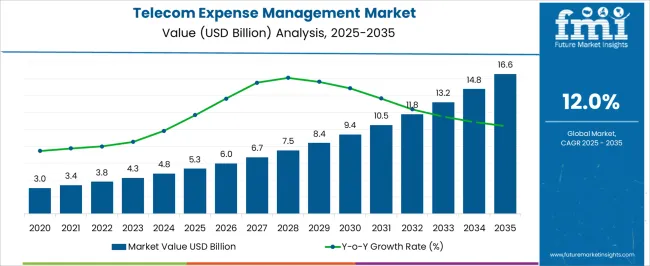
| Metric | Value |
|---|---|
| Telecom Expense Management Market Estimated Value in (2025 E) | USD 5.3 billion |
| Telecom Expense Management Market Forecast Value in (2035 F) | USD 16.6 billion |
| Forecast CAGR (2025 to 2035) | 12.0% |
The telecom expense management market is experiencing sustained growth as enterprises seek greater visibility and control over communications-related expenditures. The increasing complexity of telecom infrastructures, driven by remote work models, IoT proliferation, and multi-cloud networking, is pushing organizations to adopt centralized platforms for real-time cost monitoring and policy enforcement. Enterprises are prioritizing automation to streamline invoice processing, contract validation, and usage analytics to identify inefficiencies and prevent billing errors.
Vendors are responding by offering AI-enabled solutions that support dynamic cost forecasting and integration with enterprise financial systems. Regulatory compliance in sectors such as finance and healthcare is also influencing adoption, with audit-ready reporting and governance capabilities becoming standard expectations.
As enterprises consolidate telecom and mobility spend across regions and devices, the demand for flexible and scalable solutions is rising. Strategic alliances and managed service models are unlocking operational efficiencies, positioning telecom expense management as a foundational element in modern enterprise cost optimization.
The market is segmented by Application, Mode of Delivery, and End-Use Adoption and region. By Application, the market is divided into Financial Management, Order Management, Business Intelligence, Inventory Management, Contract Management, Dispute Management, and Others. In terms of Mode of Delivery, the market is classified into Managed Services, Complete Outsourcing, and Cloud Services. Based on End-Use Adoption, the market is segmented into BFSI, Retail, IT and Telecommunication, Healthcare, Transportation and Logistics, Manufacturing, Government and Defense, and Others. Regionally, the market is classified into North America, Latin America, Western Europe, Eastern Europe, Balkan & Baltic Countries, Russia & Belarus, Central Asia, East Asia, South Asia & Pacific, and the Middle East & Africa.
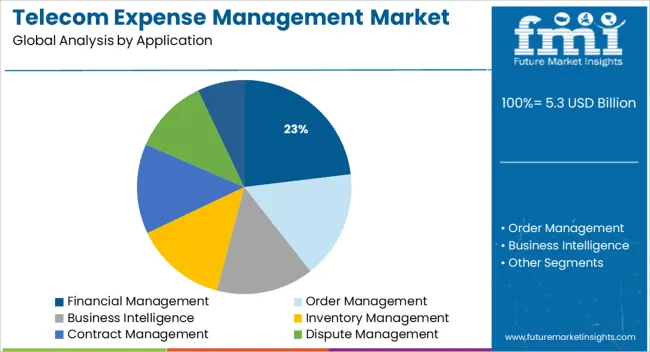
The financial management segment is projected to account for 23.1% of total revenue in 2025 within the application category, establishing it as a leading function in telecom expense management. This position is supported by the increasing enterprise focus on aligning telecom expenditures with broader financial objectives and compliance mandates.
Financial management modules enable visibility into telecom spend across departments and geographies, facilitating real-time cost tracking, budgeting, and variance analysis. Enterprises are adopting these capabilities to control cost leakage, ensure policy adherence, and improve accountability in procurement and vendor negotiations.
The integration of telecom data into enterprise resource planning systems has enhanced decision-making and enabled scenario planning. With CFOs playing a larger role in IT investment oversight, financial management applications have become critical tools in aligning telecom strategy with enterprise-wide fiscal performance goals, thereby reinforcing their revenue share.
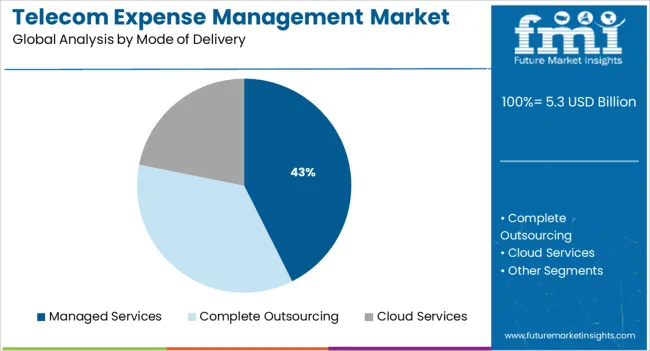
Managed services are expected to dominate the mode of delivery segment with a 42.6% revenue share in 2025, driven by enterprises increasingly outsourcing telecom lifecycle management to specialized providers. This shift is motivated by the need to reduce internal workload, gain access to expert resources, and streamline vendor interactions across complex telecom environments.
Managed services offer end-to-end solutions including contract negotiation, invoice auditing, dispute management, and real-time reporting, thereby simplifying oversight for enterprise IT and finance teams. Scalability and consistent service delivery across global operations have made this model particularly attractive to multinational corporations.
Furthermore, the ability to integrate managed services with existing ITSM and procurement platforms has enhanced operational alignment. As enterprises prioritize outcome-based partnerships and measurable cost savings, managed services are positioned to remain the dominant delivery model in telecom expense management.
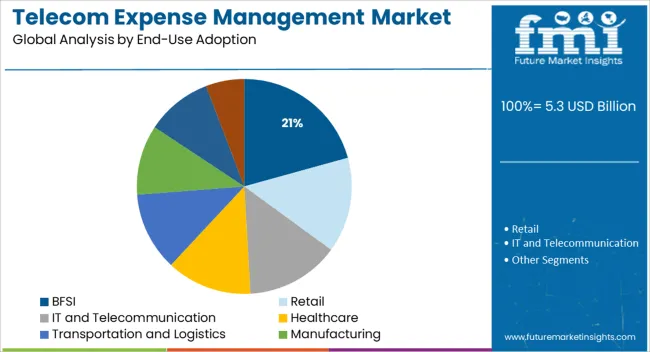
The BFSI segment is forecast to hold a 20.7% revenue share in 2025, securing its place as a key end-use industry in the telecom expense management landscape. This prominence is influenced by the sector’s regulatory intensity, high data dependency, and multi-site communication requirements. Banks, financial institutions, and insurance providers operate across diverse geographies with strict compliance frameworks, making accurate telecom spend tracking and reporting essential.
The need to optimize operational costs while maintaining secure and uninterrupted communication infrastructure has driven adoption of centralized expense management systems. Additionally, the growing use of mobile banking, secure networks, and cloud-based services has heightened the demand for real-time monitoring and cost governance.
Financial institutions are also leveraging telecom analytics to support strategic procurement and benchmark service performance. These requirements, combined with rising expectations for transparency and efficiency from regulators and shareholders, continue to drive telecom expense management investment in the BFSI sector.
As per the Telecom Expense Management Market research by Future Market Insights - a market research and competitive intelligence provider, historically, from 2020 to 2024, the market value of the Telecom Expense Management Market increased at around 13.2% CAGR.
Improvements in telecom expenditure management, such as the introduction of 5G networks and AI-driven automation technologies, will enable vendors to offer more agile and adaptable services at lower prices, allowing businesses to keep their telecom spending under check.
For instance, Tangoe, a provider of IT expenditure management and planned mobility services, launched the Tangoe Partner Experiences. Tangoe's channel partner program combines ITEM with consulting services for indirect sales companies to help organizations get the most out of their IT spending and environment.
Increased complexity has resulted from distant workforces, digital transformations, cloud adoptions, and mobility. With extensive analytics and reporting throughout the company, the Tangoe One platform provides a holistic and integrated solution spanning telecom, mobile, and cloud.
The Tangoe One platform provides a full management system for business IT needs, driven by automation as well as machine learning and artificial intelligence.
Telecom Expense Management is mostly relevant for corporate clients that require critical telecom services as part of their operations. Businesses may also utilize telecom cost management software with visual dashboards to understand how much money is spent with different telecom providers.
Companies across several industries are emphasizing Bring Your Own Device or Choose Your Own Device strategies for their workers’ cellphones and tablets. Besides, several businesses are employing mobile-based initiatives to boost employee satisfaction while also increasing productivity and lowering costs.
Financial firms and the insurance industry may be able to spend the most on prices and keep their daily communication expenses under control owing to these solutions. Cass Information Systems Inc., for example, provides financial, banking, and insurance businesses with telecommunication solutions supported by mobile service sessions and BYOD management.
There has been an increasing rivalry among service providers to develop telecom expense management services for the BFSI industry, allowing them to achieve a competitive edge over other end users. Ethio Telecommunication and the country's Information Network Security Administration officially unveiled the debut of a monthly water bill payment service using Telebirr, a mobile payment system.
Users will be able to make their payments wherever they are under the new program, which is expected to improve the speed and dependability of monthly bill collection.
Innovations in customer engagement through the provision of real-time information, as well as the ability to segment and identify consumers more readily based on their degree of service use, are likely to be the added advantages.
North America held the largest share the Telecom Expense Management market in 2024. The need for effective telecom expense management offerings will be fueled by the presence of a large number of IT services firms, the rising popularity for CYOD and BYOD rules, and the enhancement of IT and telecom infrastructures.
ReflectR, a unique reporting and analysis tool for Unified Communications and Collaboration systems, has been announced by Avotus Corporation, a key provider of communications business solutions.
ReflectR accelerates corporate adoption of UC&C by providing a robust platform for business executives to boost employee involvement through improved, single pane of glass insights not found anywhere else.
ReflectR optimises remote work settings and enables more efficient communication techniques by combining with Amazon Chime & Connect, Cisco CUCM & Jabber, MS Teams, Skype for Corporate, and other key technologies.
Due to the increased mobile device usage, the growing popularity of personal device legislation, and burgeoning IT and communications sectors, Asia Pacific is expected to see significant market growth throughout the projected period.
The telecom sector has undergone a significant transition as a result of the increasing usage of hybrid IT API architecture, with the majority of businesses transferring their corporate infrastructure to the cloud.
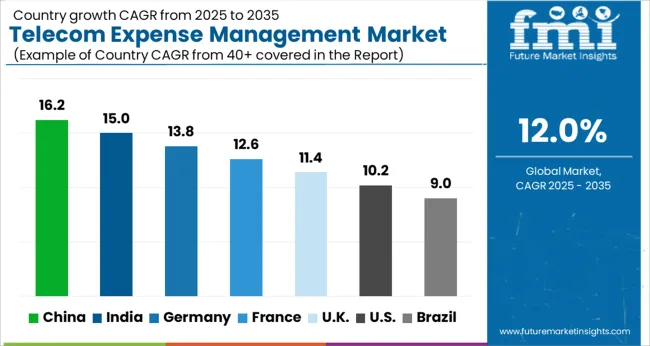
By the end of 2035, the United States is projected to account for the largest market share of USD 1.6 Billion. The continued development of digital economy plans across the US. states is taking shape, indicating that the cloud-first strategy is gaining traction in the region.
The key purpose of this initiative is to move old processes from on-premise to cloud-based services in order to connect with middleware applications throughout the whole communication sector.
At the Association of Telecommunication services Management Professionals Engage meeting, Calero-MDSL announced the debut of its latest SaaS Expense Management system. Calero MDSL's offering extends the depth and breadth of the acclaimed UCaaS solution into the larger SaaS arena, after the debut of the recognized UCaaS solution in 2024.
This enables an enterprise's expenditure management to be modernized, centralized, and optimized across their whole SaaS portfolio, demonstrating that Calero-MDSL intends to engage in the forward-looking demands of IT expense and management solutions spanning broadband, mobility, and SaaS.
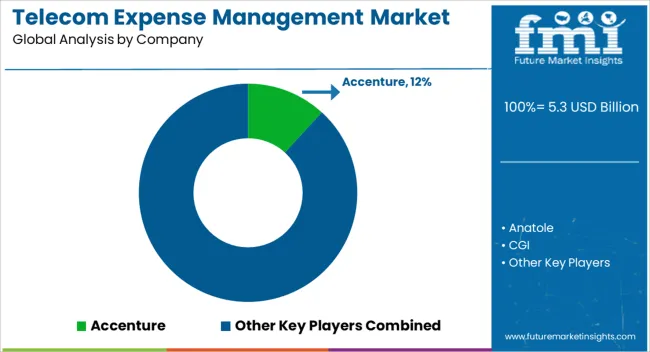
Accenture PLC, Avotus Corporation, Calero Software LLC, Tangoe Inc., and Valicom Corporation are among the key competitors in the global Telecom Expense Management industry. These players are spending in product launches, collaborations, mergers and acquisitions, and expansions to obtain a competitive advantage in the sector.
Similarly, recent developments related to companies in Telecom Expense Management services have been tracked by the team at Future Market Insights, which are available in the full report.
The global telecom expense management market is estimated to be valued at USD 5.3 billion in 2025.
The market size for the telecom expense management market is projected to reach USD 16.6 billion by 2035.
The telecom expense management market is expected to grow at a 12.0% CAGR between 2025 and 2035.
The key product types in telecom expense management market are financial management, order management, business intelligence, inventory management, contract management, dispute management and others.
In terms of mode of delivery, managed services segment to command 42.6% share in the telecom expense management market in 2025.






Full Research Suite comprises of:
Market outlook & trends analysis
Interviews & case studies
Strategic recommendations
Vendor profiles & capabilities analysis
5-year forecasts
8 regions and 60+ country-level data splits
Market segment data splits
12 months of continuous data updates
DELIVERED AS:
PDF EXCEL ONLINE
Telecom Tower Power System Market Size and Share Forecast Outlook 2025 to 2035
Telecom Mounting Hardware Market Size and Share Forecast Outlook 2025 to 2035
Telecom Testing Equipment Market Size and Share Forecast Outlook 2025 to 2035
Telecom Analytics Market Size and Share Forecast Outlook 2025 to 2035
Telecom Internet Of Things (IoT) Market Size and Share Forecast Outlook 2025 to 2035
Telecom Tower Power System Market Analysis - Size, Share, and Forecast Outlook 2025 to 2035
Telecom Network Infrastructure Market Analysis - Size, Share, and Forecast Outlook 2025 to 2035
Telecom Generator Market Size and Share Forecast Outlook 2025 to 2035
Telecom Power Rental Market Size and Share Forecast Outlook 2025 to 2035
Telecom Millimeter Wave Technology Market Size and Share Forecast Outlook 2025 to 2035
Telecom Equipment Market Size and Share Forecast Outlook 2025 to 2035
Telecom Cloud Market Size and Share Forecast Outlook 2025 to 2035
Telecom Power Systems Market Size and Share Forecast Outlook 2025 to 2035
Telecom Wireless Data Market Size and Share Forecast Outlook 2025 to 2035
Telecom Managed Service Market Trends - Growth & Forecast 2025 to 2035
Telecommunications Services Market - Growth & Forecast 2025 to 2035
Telecom Enterprise Services Market Analysis - Growth & Forecast through 2034
Telecom Service Assurance Market Trends – Size, Demand & Forecast 2023-2033
Telecom API Platform Market Growth – Trends & Forecast 2023-2033
Telecom Order Management Market Size and Share Forecast Outlook 2025 to 2035

Thank you!
You will receive an email from our Business Development Manager. Please be sure to check your SPAM/JUNK folder too.
Chat With
MaRIA